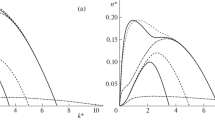Abstract
Problems of dissipative instability (in particular, overheating) in magnetohydrodynamies has been studied in [1–6]. The Leontovieh mechanism of overheating instability is explained in [I] by the example of a stationary homogeneous plasma in a strong magnetic field along which current flows. The rate of buildup of pertt∼bations is estimated in [2] to explain the effect of overheating instability on the operation of an MHD generator. The effect of inhomogeneity in the temperature field and in the boundaries of the region on the formarion of this instability has been studied by the example of discharge in a stationary medium in the absence of a magnetic field [3], Certain cases of overheating instability in magnetohydrodynamies are considered in [4, 6], where it is shown that it can be aperiodic as well as oseillatery (Alfven and acoustic waves). Finally, the hydro-dynamic and overheating branches of instability in the ease of non-isothermal plasma flow in a plane MHD channel was investigated in [6]. But the overheating instability was examined without allowance for the dependence of the viscosity and thermal-conductivity coefficients on temperature in the limiting case S 《 Rm 《 1 and only for small perturbation wavelengths. The development of shortwave perturbations is studied below with allowance for viscosity and thermal conductivity and for a wider range of conditions A 《 1. Overheating instability over the entire range of wavelengths for the ease considered in [6] is also studied.
Similar content being viewed by others
References
B. B. Kadomtsev, “Hydromagnetic stability of plasma,” collection: Problems of Plasma Theory [In Russian], No. 2, Gosatomizdat, 1963.
J. K. Wright, “A temperature instability in magnetohydrodynamic flow,” Proc. Phys. Soc., vol. 81, part 3, no. 521, 1963.
A. G. Kulikovskii and S. A. Regirer, “On the effect of walls on overheating instability in a magnetohydrodynamic channel,” PMTF[Journal Of Applied Mechanics And Technical Physics], no. 5, 1965.
Yu. V. Sanochkin, “On dissipative instability in magnetohydrodynamics,” Magnitnaya gidrodinamika [Magnetohydrodynamics], no. 3, 1965.
Yu. V. Sanochkin, “On the overheating instability of plasma,” Zh. tekhn. fiz., vol. 35, no. 6, 1965.
Yu. V. Sanochkin, “On the stability of nonisothermal plasma flow in a plane MHD channel,” PMTF [Journal Of Applied Mechanics And Technical Physics], no. 1, 1967.
J. B. Heywood, “An MHD channel flow with temperature dependent electrical conductivity,” AIAA Jour., vol. 3, no. 9, 1965.
Yu. V. Sanochkin and S. S. Filippov, “Nonisothermal plasma flow in a plane MHD channel,” PMTF [Journal Of Applied Mechanics And Technical Physics], no. 6, 1966.
A. A. Galeev, “Theory of the stability of an inhomogeneous rarefied plasma in a strong magnetic field,” Zh. eksperim. i teor. fiz., vol. 44, no. 6, 1963.
F. C. Hoh, “Complex W-K-B method, local approximations, and low density universal instability,” Phys. Fluids, vol. 8, no. 9, 1965.
S. S. Moiseev and R. Z. Sagdeev, “Effect of finite conductivity on plasma stability in a magnetic field,” Zh. tekhn. fiz., vol. 34, no. 2, 1964.
Author information
Authors and Affiliations
Additional information
The author thanks Yu. M. Zolotaikin for programming and performing the calculations.
Rights and permissions
About this article
Cite this article
Sanochkin, Y.V. Dissipative instability of a nonisothermal electrically conducting flow between parallel plates in a transverse magnetic field. J Appl Mech Tech Phys 8, 10–14 (1967). https://doi.org/10.1007/BF00915173
Issue Date:
DOI: https://doi.org/10.1007/BF00915173



